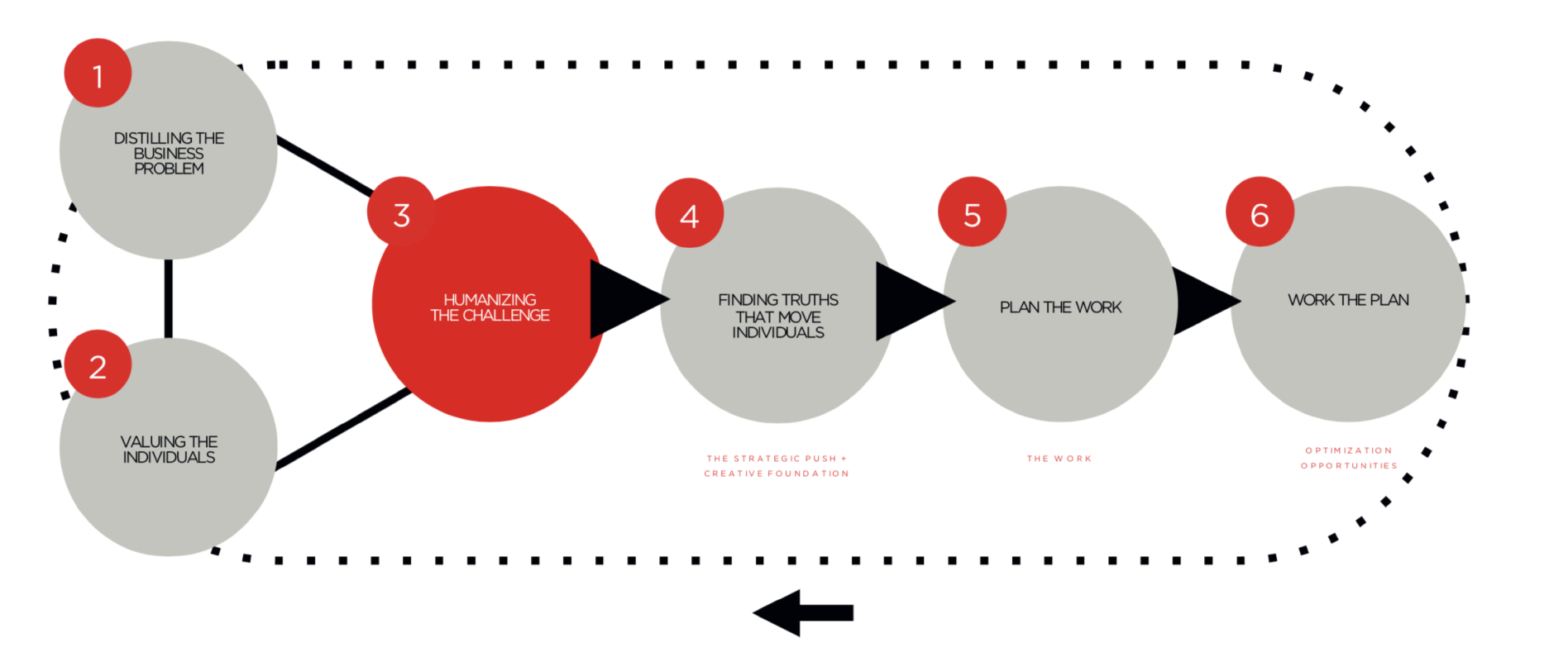
As much as we want to win creative awards with your campaigns, we’re even more #bbdoproud when we grow a client's business.
It has become a new rule, (well sort of), to ask the following questions before starting a project:
- What is the real business problem?
- Where will business growth come from?
- What audiences will grow the business?
- Where will we find the highest value and volume potential?
The idea of talking numbers (CRM, marketing and business) has always been part of BBDO’s DNA.
However today, we’ve structured that thinking in a six-step model. This forces each and everyone involved in the project to think about the business.
Hey, even our creatives talk data and numbers now! How good is that!
A pitch to remember
Do you want to know the highlight of the past year for me?
It was one specific pitch presentation. The whole team was well prepared, and everyone was on top of their game. The creative director and I were presenting the creative brand idea and concept together. Just as I was doing my very best to explain the insight in an emotional and compelling way as possible, he interrupts me with the data that helped us focus on that insight. It was a great moment.
Let me share with you BBDO WORKS: the six-step model that has helped us in this new way of thinking that permeates throughout the whole agency…

1. Distil the business problem
Our first concern is to distil and understand the REAL business problem, not just the communication goal.
For this we identify where growth will come from, and how our communication will contribute.
What area or category is showing underexploited business potential?
Can we detect potential churners and focus our efforts there?
2. Value the individuals
In other words we identify and value the individuals that will provide the business growth. By mapping the potential value, volume and needs of these potential groups, we can prioritise our communication efforts for you.
Is our core audience for baby food really just young parents? Or should we target other audiences for growth, like grandparents, day care centres…?
Are students the biggest growth audience for the toilet paper market because they use it as cleaning paper? What is their total lifetime value?
3. Humanise the challenge
How can we “move” the consumers that will move your business forward? This step humanises the business challenge into a provocative, yet effortlessly clear brand idea, and becomes the basis for an overarching creative platform.
Should we convince kids to play with Barbie again? Or should we convince moms of the fact that Barbie represents whoever your girl wants to become, and not just a stereotypical bimbo?
Should we keep the masculinity of the Jupiler brand? Or should Jupiler redefine what respectful masculinity is in a world where masculinity as such is often negatively charged?
4. Find the truth
In this way we feed our creatives with insights or truths that will move sub-audiences the most. This data comes from customers’ first party data, and from partners like Google, Facebook and Spotify... as well as market reports and quali and quanti research.
Parents with kids older than six years might want to go to Walibi because the kids (and parents) are now less excited about Plopsa.
Parents with kids over 1m40 should consider celebrating this ‘growing big’ moment with a day at Walibi.
For parents in a newly composed family, Walibi has the potential to be a day of unanimity and joined fun.
5. Plan the work
We plan the work using an audience map and end-to-end journeys, while also identifying the most optimal touchpoints, messages, CTAs and KPIs for each sub-audience. It’s a starting point for programmatic and continuous optimisation.
How can we improve the customer journey?
Can we improve car sales talks based on insights captured during the configuration, and based on previous interaction with our banners or posts?
6. Re-work the plan
In short, there isn’t a long, subjective validation process.
Instead, we continuously re-work the plan and creative output based on consumers’ previous interaction with our work. So it’s the consumer who decides!
What channels haven’t performed as expected? Should we shuffle our investments?
What version doesn’t deliver the expected number of click-throughs? What CTA? Copy? Colour? Format?
Waiting room next to the data analysts’ desks
Luckily, we – the strategists – don’t have to come up with all the answers ourselves.
Since everyone in the agency has started eating and breathing business and data thinking, our data analysts have considered installing a waiting room beside their desks! The fact is they are no longer a separate team working on separate projects. They are involved in everything… and wanted by everybody.
They analyse 1st, 2nd and 3rd party data, including data sets or reports that are available at the clients’ premises, or that we buy from third parties, or that we borrow from partners like Google, Gfk, Bisnode.
The strategy team formulates hypotheses for each of the steps based on where we think business might come from, and which audiences might have good potential, or on insights that connect well with our target audiences. These hypotheses are then checked by our data analysts.
Make it happen!
So, when do we feel our job is a success? When we make things happen!
When we are able to bring together all the data and reports (often left at clients by various consultancy firms), fill in the missing data and turn it into something real. Get things out there.
Build great concepts, shoot spectacular movies, write convincing copy, design attractive visuals… then test the results and optimise when necessary.
The creative work is of course still the core of our business.
But it’s cool to see how much data and business knowledge now impact the entire creative process. Creative ideas that move the audience and move the business!
Need some help?
You want to learn to eat, live and breathe data too? Don’t hesitate to reach out.
Written by Sofie Verstreken, Chief Strategy Officer
#drawing #running #singing
Filed under INSPIRATION